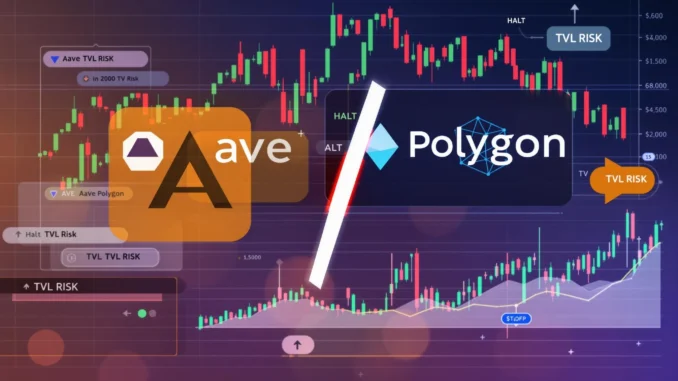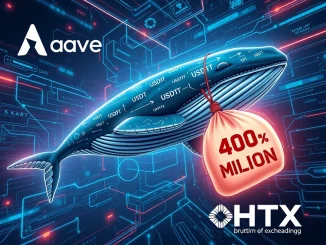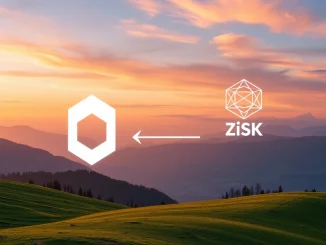
Hold onto your hats, DeFi enthusiasts! A significant shift is unfolding in the crypto lending landscape. Leading decentralized lending platform Aave has just pressed pause on lending activities on Polygon’s Proof-of-Stake (PoS) chain. This bold move, impacting a staggering $300 million in Total Value Locked (TVL), has sent ripples through the crypto community. Let’s dive into what’s happening, why Aave is pulling back, and what this means for your crypto holdings.
Why Aave is Halting Lending on Polygon: Understanding the DeFi Lending Implications
The decision to halt lending on Polygon wasn’t taken lightly. It stems from a proposal approved by the Aave community, effectively setting the Loan-to-Value (LTV) ratios for stablecoins on Polygon PoS to 0%. In layman’s terms, this means no more lending of stablecoins through Aave on Polygon. But why the sudden stop?
The primary driver behind this decision is risk. Aave’s risk assessment framework flagged concerns regarding a proposed plan by Polygon to deploy a massive $1 billion in stablecoins for yield generation. Aave’s governance deemed this plan too risky, potentially jeopardizing the platform’s stability and user funds. This proactive measure highlights the inherent volatility and risk management considerations within the rapidly evolving world of DeFi Lending.
Here’s a breakdown of the key factors at play:
- Risk Mitigation: Aave prioritized risk mitigation due to concerns over Polygon’s proposed $1 billion stablecoin yield strategy.
- Community Vote: The proposal to halt lending passed with a significant majority – over 692,000 votes in favor versus 117,000 against, as reported by The Block. This demonstrates strong community alignment on the risk concerns.
- TVL at Stake: Over $300 million in TVL is directly affected by this halt, underscoring the scale of Aave’s presence on Polygon and the potential impact on users.
- Polygon’s Disappointment: Despite Polygon Labs CEO Marc Boiron expressing hope for reconsideration, the decision is now set to be implemented, indicating a firm stance from Aave.
The $300M TVL Risk: What Does This Mean for Polygon Users?
The immediate impact of Aave halting lending is on the $300 million TVL currently engaged in lending activities on Polygon through Aave. Users who were leveraging Aave for borrowing and lending stablecoins on Polygon will need to adjust their strategies.
Let’s consider the potential scenarios:
- Reduced Lending Opportunities: Users seeking to lend stablecoins on Polygon via Aave will no longer be able to do so. This could lead to a decrease in overall lending activity on Polygon’s PoS chain, at least temporarily.
- TVL Migration: Some portion of the $300 million TVL may migrate to other DeFi platforms or even to other chains seeking lending opportunities. This could impact Polygon’s overall DeFi ecosystem metrics.
- Market Volatility: Significant shifts in TVL can sometimes contribute to market volatility, although the extent of this impact remains to be seen.
- Opportunity for Alternatives: This situation might create opportunities for other DeFi lending platforms to step in and fill the gap left by Aave on Polygon, fostering competition and innovation.
Crypto Lending Halt: A Sign of Increased Scrutiny in DeFi?
Aave’s decision to halt lending on Polygon PoS can be interpreted as a sign of increased scrutiny and a more cautious approach within the DeFi space. As the DeFi sector matures, risk management is becoming paramount. Platforms are increasingly prioritizing the security and sustainability of their protocols, even if it means making tough decisions that might impact short-term growth or user activity.
This incident underscores several key takeaways for the DeFi ecosystem:
- Governance Matters: Aave’s community-driven governance process played a crucial role in this decision, highlighting the importance of decentralized decision-making in DeFi.
- Risk Assessment is Key: Robust risk assessment frameworks are essential for the long-term viability of DeFi platforms. Aave’s actions demonstrate a commitment to proactive risk management.
- Transparency and Communication: Open communication from platforms like Aave regarding their risk assessments and decisions builds trust within the community.
- Evolving DeFi Landscape: The DeFi landscape is constantly evolving, and platforms must adapt to emerging risks and opportunities to remain competitive and secure.
Navigating TVL Risk and DeFi Volatility: Actionable Insights
For crypto users and DeFi participants, Aave’s move serves as a valuable lesson in navigating the inherent risks of the decentralized finance world. Here are some actionable insights to consider:
- Diversification: Don’t put all your eggs in one basket. Diversify your DeFi portfolio across multiple platforms and chains to mitigate risk.
- Due Diligence: Thoroughly research DeFi platforms before engaging with them. Understand their risk management protocols, governance mechanisms, and security measures.
- Stay Informed: Keep abreast of developments in the DeFi space, including governance proposals, risk assessments, and platform updates. News outlets and community forums are valuable resources.
- Risk Tolerance: Assess your own risk tolerance and align your DeFi strategies accordingly. DeFi offers high potential rewards but also comes with significant risks.
- Understand TVL: TVL is a crucial metric in DeFi, but it’s not the only one. Consider other factors like protocol security, community engagement, and tokenomics when evaluating DeFi platforms.
Conclusion: Aave’s Bold Move and the Future of Crypto Lending
Aave’s decision to halt lending on Polygon PoS, while potentially disruptive in the short term, reflects a mature and responsible approach to DeFi risk management. It underscores the importance of prioritizing platform stability and user safety in the face of emerging challenges. As the DeFi space continues to evolve, expect to see more nuanced risk assessments and proactive measures from leading platforms. This incident serves as a crucial reminder of the dynamic and often unpredictable nature of crypto, urging users to stay vigilant, informed, and prepared for change. The future of Crypto Lending will likely be shaped by such decisions, emphasizing security and sustainability alongside innovation and growth.



